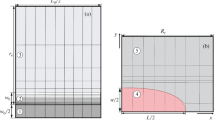Abstract
Two approaches to the determination of the optimum conditions of the well bottom zone treatment in a carbonate formation are considered and compared. The first, bench approach is based on the investigation of the process of wormhole formation in rock cores, while the second approach is the mathematical modeling of the process within the framework of mechanics of multi-component seepage flows using averaged values of the reservoir porosity and permeability. A mathematical model of the process, that takes account for fluid flow and the chemical reaction between the acid and the rock matrix proceeding in the kinetic regime, is presented. Both approaches indicate the existence of an optimum rate of acid solution injection into the formation at a certain given value of the dimensionless Damköller number.
Similar content being viewed by others
References
J.C. Labrid, “Stimulation chimique: Étude théorique et expérimentale des équilibres chimiques décrivant l’attaque fluohydrique d’un grès argileux,” Rev. d’Inst. du Pétrole 26, 855 (1971).
G. Daccord, E. Touboul, and R. Lenormand, “Carbonate Acidizing. Toward a Quantitative Model of the Wormholing Phenomena,” SPE Prod. Engng 4(1), 63 (1989).
M.L. Hoefner and H.S. Folger, “Pore Evolution and Channel Formation during Flow and Reaction in Porous Media,” AIChE J. 34(1), 45 (1988).
C.N. Fredd, “Advances in Understanding and Predicting Wormhole Formation,” Appendix in: M.J. Economides and K.G. Nolte, Reservoir Simulation, Wiley, New York (2000).
C.N. Fredd and H.S. Folger, “Optimum Conditions for Wormhole Formation in Carbonate Porous Media: Influence of Transport and Reaction,” SPE J. 4, 196 (1999).
K.M. Fedorov, “Unsteady Flow through a Porous Medium in the Presence of Chemical Reactions,” Fluid Dynamics 22(1), 70 (1987).
G.I. Barenblatt, V.M. Entov, and V.M. Ryzhik, Theory of Unsteady Seepage Flows of Liquids and Gases [in Russian], Nedra, Moscow (1972).
V.E. Andreev and K.M. Fedorov, “Analysis of Hydrodynamics of the Process of Underground Leaching of Carbonate Rocks,” Izv. Vuzov. Neft’ i Gaz No. 12, 52 (1986).
A.Yu. Namiot, Phase Equilibrium in Oil Extraction [in Russian], Nedra, Moscow (1976).
P.W. Atkins, Physical Chemistry, Oxford Univ. Press, Oxford (1978).
V.M. Entov and A.F. Zazovskii, Hydrodynamics of the Processes of Increasing Oil Yield [in Russian], Nedra, Moscow (1976).
V.N. Nikolaevskii, E.A. Bondarev, M.I. Mirkin, G.S. Stepanova, and V.P. Terzi, Motion of Hydrocarbon Mixtures in Porous Media [in Russian], Nedra, Moscow (1968).
Additional information
Original Russian Text © A.S. Smirnov, K.M. Fedorov, A.P. Shevelev, 2010, published in Izvestiya Rossiiskoi Akademii Nauk, Mekhanika Zhidkosti i Gaza, 2010, Vol. 45, No. 5, pp. 113–121.
Rights and permissions
About this article
Cite this article
Smirnov, A.S., Fedorov, K.M. & Shevelev, A.P. Modeling the acidizing of a carbonate formation. Fluid Dyn 45, 779–786 (2010). https://doi.org/10.1134/S0015462810050108
Received:
Published:
Issue Date:
DOI: https://doi.org/10.1134/S0015462810050108




